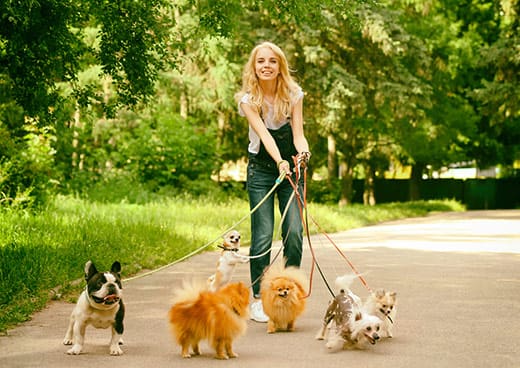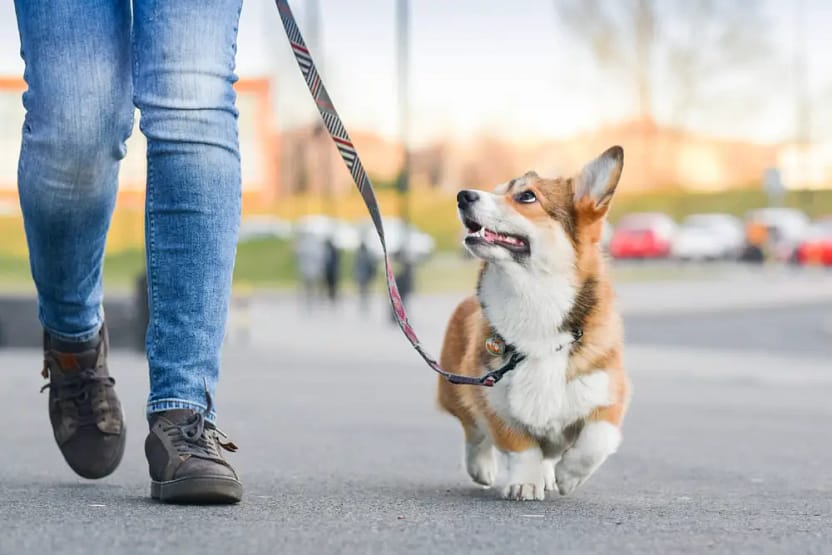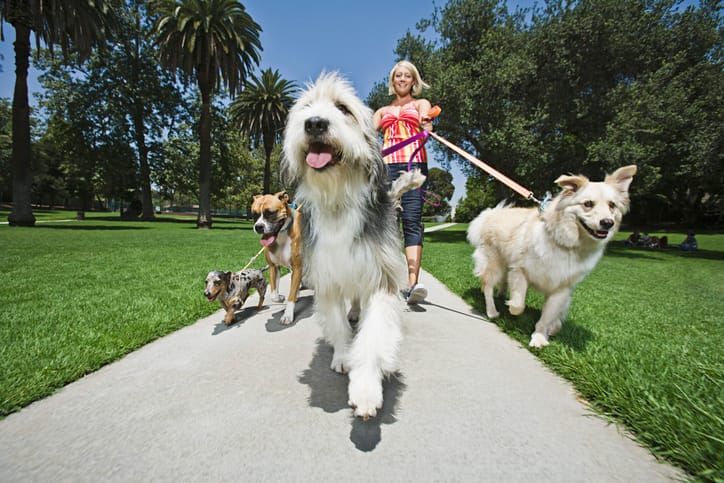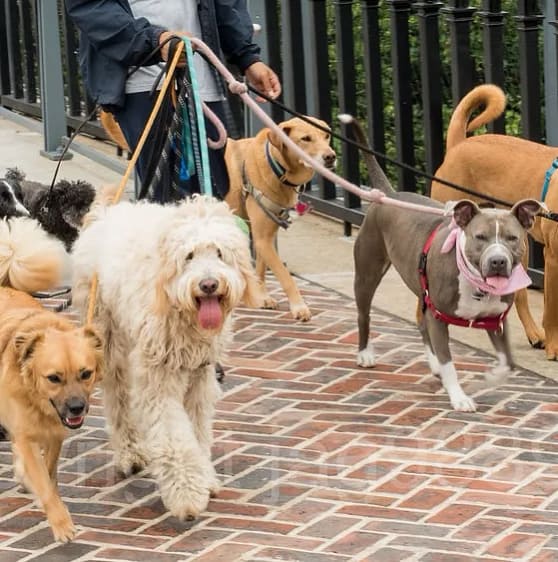
Dog walking jobs can be a fulfilling and rewarding career choice for those who have a love for animals. It is an excellent opportunity to earn money while spending time with furry friends. Whether you are looking for a full-time job or just some extra cash, dog walking is a great option that allows you to work independently and build your own business.
As cities continue to grow, more people are turning to pet care services like dog walking. This trend has created a high demand for responsible and reliable individuals who can provide quality care for pets while their owners are away.
In this article, we will explore the basics of dog walking jobs, including how to build your skills, set up your business, create long-term relationships with clients, and grow your business over time. Whether you’re passionate about dogs or simply looking for a way to make ends meet, there’s never been a better time to start exploring the world of professional dog walking.
Key Takeaways
- Dog walking is a fulfilling and rewarding career with high demand for responsible and reliable individuals.
- Building skills such as basic dog training, understanding behavior and body language, and prioritizing safety is important for success in dog walking jobs.
- Successful dog walking businesses require a solid plan, target market definition, and marketing strategies, as well as excellent communication skills and the ability to handle difficult situations calmly and assertively.
- Diversifying income streams, considering legal considerations for hiring employees versus contractors, and networking and building reputation through events and social media are also important factors to consider in the dog walking industry.
Understanding the Basics

You’ll need to understand the basics if you want to start walking dogs for a living.
First and foremost, you should be familiar with the going rates for dog walking services in your area. This will help you set competitive prices that won’t drive away potential clients.
In addition to knowing dog walking rates, it’s also important to know how to find clients. You can start by asking friends and family members if they need a dog walker or by posting flyers in local pet stores or vet clinics.
You can also sign up for online platforms that connect pet owners with dog walkers, such as Rover or Wag! With some effort and persistence, you can build up a solid client base and turn your love for dogs into a fulfilling career.
Building Your Dog Walking Skills

To become a skilled dog walker, you must possess knowledge of basic dog training techniques. Understanding a dog’s behavior and body language is also essential. Prioritizing safety while walking dogs is crucial.
Basic training techniques include commands such as ‘sit’ and ‘stay,’ which can help control the dog’s behavior during walks.
Understanding a dog’s body language can also help prevent potential conflicts with other animals or humans.
Additionally, safety tips such as using sturdy leashes and being aware of surroundings can ensure that both the walker and the dog remain safe during their outings.
Basic Dog Training Techniques

Dog training is absolutely essential if you want your furry friends to behave properly. One of the most effective training techniques is positive reinforcement, which involves rewarding good behavior instead of punishing bad behavior. This technique not only helps in shaping your dog’s behavior but also strengthens the bond between you and your pet.
Leash training is another crucial aspect of dog training that helps in keeping both the dog and the walker safe during walks. Starting with short walks and gradually increasing the duration can help a dog get accustomed to walking on a leash. Consistency and patience are key when it comes to leash training as it may take some time for dogs to learn how to walk alongside their owners without pulling or tugging at the leash.
With proper training, dogs can become well-behaved companions on daily walks.
Dog Behavior and Body Language

When your furry friend is feeling anxious or scared, their body language will often reflect their emotions through trembling, cowering, or even hiding. Understanding dog behavior and interpreting body language is essential for dog walkers to keep themselves and the dogs they walk safe.
Here are some common signs of dog behavior that walkers should learn to interpret:
- Tail position: A relaxed tail indicates a friendly mood, while a tucked tail means the dog feels fearful or submissive.
- Ears: If the ears are forward, the dog is alert and interested in something; if they’re flat against the head, it means the dog is scared or aggressive.
- Eye contact: Direct eye contact from a strange dog can be seen as a threat. Dogs who avoid eye contact may be afraid.
- Growling: This can be an indication that a dog feels threatened and may bite.
Being able to read your furry friend’s body language can help you understand how they’re feeling and respond appropriately. By doing so, you can build trust with them while out on walks.
Safety Tips for Dog Walking
Staying safe while taking your furry companion out for a walk is crucial, as it doesn’t just protect you but also ensures your pet remains happy and healthy.
Therefore, it’s essential to follow some safety tips to avoid any accidents or mishaps. One of the most important things to keep in mind is to wear proper safety gear, such as comfortable shoes with good grip, reflective clothing, and a whistle. These items can help you prevent any accidents or injuries and make sure that you’re visible to others while walking.
Another crucial aspect of dog walking safety is emergency preparedness. It’s always a good idea to carry a first aid kit with you that includes necessary items like bandages, antiseptic wipes, tweezers, scissors, etc. Additionally, it would be best if you also carried an extra leash and collar just in case yours gets damaged or lost during the walk.
Lastly, always have your phone charged and ready so that you can call for help in case of an emergency. Follow these simple tips to ensure a safe and enjoyable experience for both you and your furry friend on every walk!
Setting Up Your Dog Walking Business

When you start your dog walking business, envision yourself as a professional who’s passionate about providing quality care for pets. Creating a successful venture is crucial to developing a solid business plan that outlines your goals and strategies.
Define your target market, determine the services you’ll offer, set pricing and map out your costs. This will help you stay focused on the big picture and make informed decisions along the way.
Marketing strategies are also key to building your client base and growing your business. Start by identifying where pet owners in your area spend their time online or offline, then tailor your messaging accordingly.
Establishing a social media presence can be an effective way to reach potential clients, while networking with veterinarians or pet stores could lead to valuable referrals. Don’t forget about traditional advertising methods like flyers or posters in local parks – every little bit helps when it comes to spreading the word about your new dog walking business!
Building Long-Term Relationships with Clients
To build long-term relationships with clients as a dog walker, you must possess excellent communication skills.
The ability to listen actively, understand the clients’ needs, and provide regular updates can help establish trust and loyalty.
Handling difficult situations in a calm and professional manner is also crucial, as unexpected issues may arise while walking dogs.
Additionally, providing exceptional customer service by going above and beyond for clients can help set your business apart from competitors in the industry.
Communication Skills
You’ll need sharp communication skills to keep both the dogs and their owners happy, so don’t be afraid to use humor or personal anecdotes to make a connection. Active listening is essential when communicating with clients because it shows that you care about their needs and are willing to address any concerns they may have. In addition, conflict resolution skills will come in handy when dealing with difficult situations such as unruly dogs or misunderstandings with clients.
To evoke emotion in the audience, consider these sub-lists:
- Ways to show empathy towards clients:
- Acknowledge their concerns
- Offer solutions instead of excuses
- Follow up on their feedback
- Ways to create a bond with dogs:
- Use positive reinforcement techniques
- Learn their favorite toys and treats
- Be consistent with commands and routines
- Benefits of building strong relationships:
- Increase client loyalty and satisfaction
- Receive more referrals from satisfied customers
- Develop a sense of fulfillment from serving others
By honing your communication skills, you’ll not only improve your job performance but also enhance your personal relationships. Keep an open mind and be willing to adapt your approach depending on the situation at hand. With practice, you’ll become an expert at navigating complex interactions between dogs and humans alike.
Handling Difficult Situations
When faced with challenging circumstances while dog walking, it can feel like you’re walking on a tightrope without a safety net. Dealing with aggression from other dogs or even the dog you’re walking can be intimidating and stressful. However, it’s important to remember that staying calm and assertive is key in these situations.
One way to handle aggression is to try to redirect the dog’s attention by giving them a toy or treat. If that doesn’t work, it’s best to remove yourself and the dog from the situation as quickly and calmly as possible.
It’s also important to know your own limits – if you don’t feel comfortable handling an aggressive dog, it’s okay to decline the job or ask for help from a more experienced walker.
On the other hand, calming anxious dogs can also be challenging but rewarding. Patience and understanding are key when helping an anxious pup feel more at ease during walks.
Providing Exceptional Customer Service
After learning how to handle difficult situations when walking dogs, it’s time to focus on providing exceptional customer service. Effective communication is key in building strong relationships with clients and managing their expectations. As a dog walker, being able to communicate clearly and promptly can make all the difference in ensuring that clients are satisfied with your services.
One way to provide exceptional customer service is by setting clear expectations from the start. This includes discussing details such as the length of walks, any specific requests or needs for the dog, and scheduling preferences. By doing so, both parties will have a better understanding of what to expect and can avoid any potential misunderstandings.
Additionally, staying in touch with clients through regular updates and responding promptly to any questions or concerns can help build trust and loyalty. Managing client expectations through effective communication is essential for creating a positive experience for both the client and their furry friend.
Growing Your Dog Walking Business
To grow their dog walking business, a walker may consider expanding their services beyond just walks. They could also hire employees or contractors to take on more clients and increase revenue.
Networking and building a positive reputation through word of mouth can also attract new clients and help the business thrive.
Expanding Your Services
If you’re looking to grow your business, you might consider adding some extra offerings to your dog walking services.
Expanding services and diversifying income can be a great way to attract new clients and keep your existing ones happy. Some additional services that you can offer include pet sitting, pet transportation, and even dog grooming.
By offering these additional services, you are giving your clients more options for their pets’ care needs. For example, if a client is going on vacation and needs someone to take care of their pet while they’re away, they may be more likely to choose you if you also offer pet sitting.
Additionally, by diversifying your income streams with these extra offerings, you can increase your revenue potential and make it easier to weather slow periods in the dog walking market.
Overall, expanding your services is a smart move for any dog walking business owner looking to take their enterprise to the next level.
Hiring Employees and Contractors
When you’re ready to expand your business, consider hiring employees or contractors to help with the workload. Deciding between the two can be tricky as they have different legal considerations and requirements.
An employee is someone who works for you on a regular basis and whose work you direct and control. Contractors, on the other hand, are self-employed and provide services to your business but maintain their own autonomy.
Legal considerations are important when making this decision as there are different laws that apply to employees versus contractors. It’s important to consult a lawyer or accountant before hiring anyone to ensure that you’re complying with all applicable laws and regulations.
Recruitment strategies and interview tips can help ensure that you find the right fit for your business needs while also ensuring that you treat potential candidates fairly throughout the hiring process.
Networking and Building Your Reputation
Networking and building your reputation is crucial for the success of your dog walking business. It allows you to establish meaningful connections with other professionals in the industry and showcase your expertise in a way that can attract potential clients or partnerships. Attending networking events, such as pet expos or local business gatherings, can be a great way to meet new people and expand your reach.
In addition to attending events, having a strong social media presence can also help build your reputation. Creating engaging content and sharing it on platforms like Instagram or Facebook can help you connect with potential clients who may be searching for dog walkers online. Building relationships with existing clients by offering exceptional service and asking for referrals can also go a long way in growing your business.
| Pros | Cons | ||
|---|---|---|---|
| Meet new people in the industry | Can be time-consuming | ||
| Expand reach beyond current client base | May not lead to immediate results | ||
| Opportunity for partnerships or collaborations | Requires effort to maintain relationships | ||
| Showcase expertise and knowledge | Can be overwhelming for introverted individuals | Can lead to increased brand recognition and credibility. |
Frequently Asked Questions
What qualifications or certifications are required to become a professional dog walker?
To become a professional dog walker, essential skills include time management and training methods. While no formal qualifications are required, certifications such as pet first aid and CPR can increase credibility and expertise.
How do you handle difficult or aggressive dogs while on a walk?
Dealing with aggression in dogs while on a walk can be challenging. Calming techniques such as redirecting their attention, using positive reinforcement, and maintaining a calm demeanor can help diffuse the situation.
What is the average hourly rate for a dog walker and how does it vary by location?
How much does a dog walker make per hour? Hourly rates vary by location, but the national average is $15-$20. In urban areas, walkers can earn up to $30/hr. Rural areas tend to pay less.
How do you ensure the safety of both the dog and the walker during walks?
To ensure safety during dog walks, proper training techniques and emergency preparedness are crucial. Walkers should have knowledge of first aid, carry necessary supplies, and be vigilant for potential hazards. The well-being of both the dog and walker is a top priority.
What insurance or liability coverage is necessary for a dog walking business?
Liability coverage and insurance requirements are crucial for any business, including dog walking. Without them, the owner could be held responsible for accidents or injuries that occur during walks. It is important to research and obtain proper coverage before starting a dog walking business.
See Also:
- How To Become A Professional Dog Trainer
- Cane Corso and Doberman Pinscher Mix – Powerful Partners in Strength and Loyalty
- Fun Facts About Dogs: Discovering the Delightful Canine World
Conclusion
In conclusion, dog walking jobs can be a rewarding and lucrative career for those who love spending time with furry friends. By understanding the basics of dog behavior and building your skills through experience and education, anyone can become a successful dog walker.
With determination and hard work, setting up your own dog walking business is an achievable goal that can provide you with a fulfilling lifestyle. As you grow your business, it’s important to maintain long-term relationships with clients by providing exceptional care and service to their beloved pets.
Building trust and rapport within the community will help you expand your client base and continue to grow your business. So why not take the leash and start on this exciting journey as a professional dog walker? Enjoying fresh air, exercise with our four-legged friends while getting paid – it’s like living in a dream!
Join the Journey of Compassion: Support Bone Voyage Dog Rescue Today and Help Save Lives!
